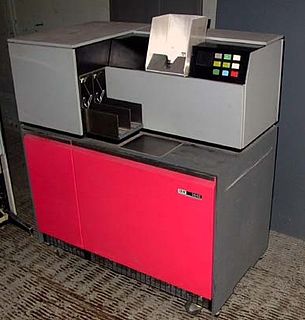IBM mainframes are large computer systems produced by IBM since 1952. During the 1960s and 1970s, IBM dominated the large computer market. Current mainframe computer in IBM's line of business computers are developments of the basic design of the IBM System/360.
MAD is a programming language and compiler for the IBM 704 and later the IBM 709, IBM 7090, IBM 7040, UNIVAC 1107, UNIVAC 1108, Philco 210-211, and eventually the IBM S/370 mainframe computers. Developed in 1959 at the University of Michigan by Bernard Galler, Bruce Arden and Robert M. Graham, MAD is a variant of the ALGOL language. It was widely used to teach programming at colleges and universities during the 1960s and played a minor role in the development of CTSS, Multics, and the Michigan Terminal System computer operating systems.

The IBM 7090 is a second-generation transistorized version of the earlier IBM 709 vacuum tube mainframe computer that was designed for "large-scale scientific and technological applications". The 7090 is the third member of the IBM 700/7000 series scientific computers. The first 7090 installation was in November 1959. In 1960, a typical system sold for $2.9 million or could be rented for $63,500 a month.

The IBM 700/7000 series is a series of large-scale (mainframe) computer systems that were made by IBM through the 1950s and early 1960s. The series includes several different, incompatible processor architectures. The 700s use vacuum tube logic and were made obsolete by the introduction of the transistorized 7000s. The 7000s, in turn, were eventually replaced with System/360, which was announced in 1964. However the 360/65, the first 360 powerful enough to replace 7000s, did not become available until November 1965. Early problems with OS/360 and the high cost of converting software kept many 7000s in service for years afterward.
The Compatible Time-Sharing System (CTSS), was one of the first time-sharing operating systems; it was developed at the MIT Computation Center. CTSS was first demonstrated in 1961 and was operated at MIT until 1973. During part of this time, MIT's influential Project MAC also ran CTSS, but the system did not spread beyond these two sites.
The University of Michigan Executive System, or UMES, a batch operating system developed at the University of Michigan in 1958, was widely used at many universities. Based on the General Motors Executive System for the IBM 701, UMES was revised to work on the mainframe computers in use at the University of Michigan during this time and to work better for the small student jobs that were expected to be the primary work load at the University.
IBSYS is the discontinued tape-based operating system that IBM supplied with its IBM 7090 and IBM 7094 computers. A similar operating system, also called IBSYS, was provided with IBM 7040 and IBM 7044 computers. IBSYS was based on FORTRAN Monitor System (FMS) and SHARE Operating System.
In computer programming, the name .bss or bss is used by many compilers and linkers for the portion of an object file or executable containing statically-allocated variables that are not explicitly initialized to any value. It is often referred to as the "bss section" or "bss segment".
Alick Edwards Glennie (1925–2003) was a British computer scientist, most famous for having developed Autocode, which many people regard as the first ever computer compiler.

SHARE Inc. is a volunteer-run user group for IBM mainframe computers that was founded in 1955 by Los Angeles-area users of the IBM 701 computer system. It evolved into a forum for exchanging technical information about programming languages, operating systems, database systems, and user experiences for enterprise users of small, medium, and large-scale IBM computers such as IBM S/360, IBM S/370, zSeries, pSeries, and xSeries. Despite the capitalization of all letters in the name, the official website says "SHARE is not an acronym; it's what we do."

From the invention of computer programming languages up to the mid-1970s, most computer programmers created, edited and stored their programs line by line on punched cards.
The SHARE Operating System (SOS) was created in 1959 as an improvement on the General Motors GM-NAA I/O operating system, the first operating system, by the SHARE user group. The main target was to improve the sharing of programs over GM-NAA I/O.
A strap is a ribbon used to fasten.

A computer punched card reader or just computer card reader is a computer input device used to read computer programs in either source or executable form and data from punched cards. A computer card punch is a computer output device that punches holes in cards. Sometimes computer punch card readers were combined with computer card punches and, later, other devices to form multifunction machines.
It is a input device and also an output device.
Most early computers, such as the ENIAC, and the IBM NORC, provided for punched card input/output. Card readers and punches, either connected to computers or in off-line card to/from magnetic tape configurations, were ubiquitous through the mid-1970s.
BCD, also called alphanumeric BCD, alphameric BCD, BCD Interchange Code, or BCDIC, is a family of representations of numerals, uppercase Latin letters, and some special and control characters as six-bit character codes.

The IBM 711 was a punched card reader used as a peripheral device for IBM mainframe vacuum tube computers and early transistorized computers. Announced on May 21, 1952, it was first sold with the IBM 701. Later IBM computers that used it were the IBM 704, the IBM 709, and the transistorized IBM 7090 and 7094.






